Faded tiles, antique mirrors, and weathered brass fixtures are making a strong comeback in modern homes with a nostalgic twist. The growing love for vintage bathroom ideas isn’t just about charm—it’s about blending character with practicality. Whether you’re restoring an older home or want to inject heritage-inspired personality into a newer space, these ideas offer clever, functional beauty rooted in history. This curated guide reveals unique, problem-solving vintage elements that are easy to implement and genuinely inspiring. Each idea highlights why vintage style remains relevant in 2025, helping you create a bathroom that’s as memorable as it is timeless.
Clawfoot Tub with Brass Fixtures
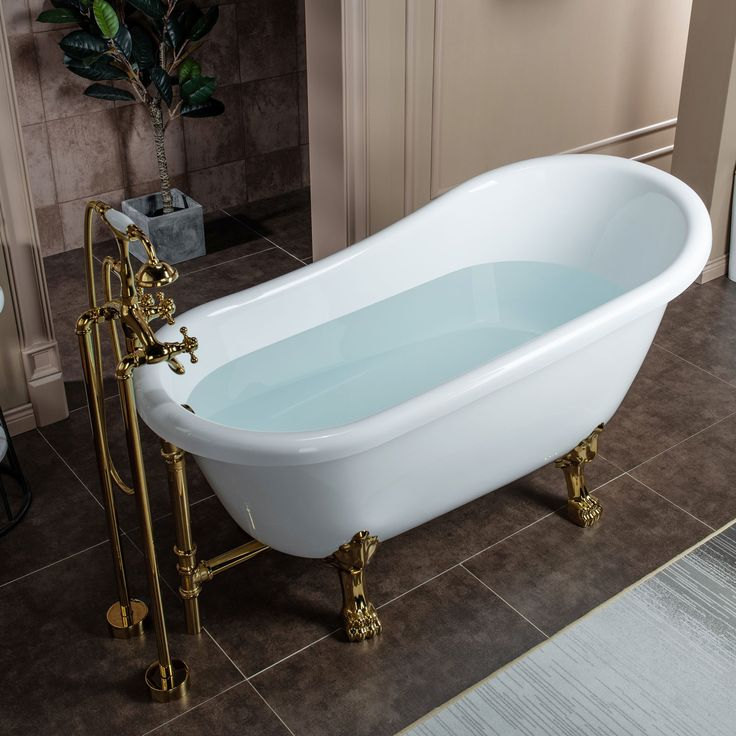
Nothing brings vintage luxury into a bathroom like a clawfoot tub fitted with polished brass fixtures. These standalone tubs evoke old-world charm and offer a sculptural focal point ideal for period-inspired interiors. Brass finishes naturally patina over time, adding authenticity and visual warmth to the space. When paired with white porcelain or matte enamel finishes, the contrast feels both classic and upscale. It’s essential to place the tub where it can stand out—preferably centered under a window or beneath a decorative chandelier. For flooring, white hexagon tiles or herringbone marble can complement this arrangement beautifully. To maintain consistency, coordinate other metal details such as towel bars and mirror frames in the same brass tone. This setup doesn’t just enhance visual appeal—it also delivers functionality and timeless comfort. Use modern plumbing hardware discreetly so the vintage aesthetic remains unspoiled. For bathrooms with limited space, smaller clawfoot tub models still deliver the same aesthetic payoff. Finish the scene with a traditional bath tray or vintage-style linens to tie everything together. This design choice resonates with homeowners seeking an elegant, curated space that feels luxurious and lived-in, making it one of the most pinned vintage bathroom looks today.
Heritage Wallpaper with Paneling
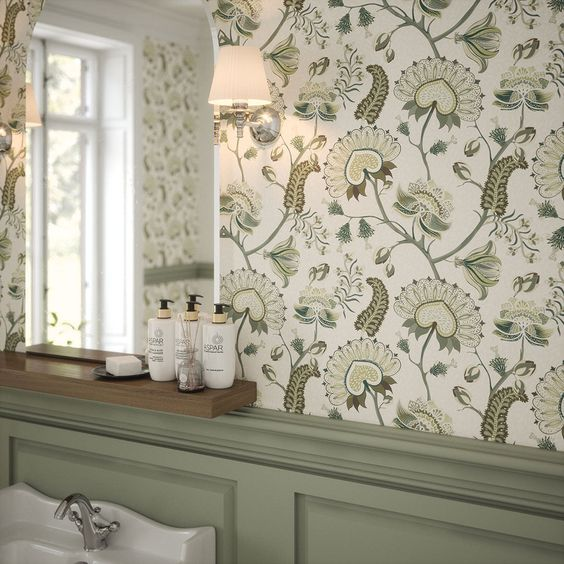
Wallpaper with heritage prints can instantly establish a nostalgic, storied atmosphere, especially when paired with classic paneling. Floral damask, toile, and Victorian medallion patterns are popular choices, offering timeless motifs that elevate wall surfaces beyond basic paint. When framed by crisp white or painted wood paneling along the lower half of the wall, these wallpapers stand out without overwhelming the room. Paneling not only grounds the print but also adds texture and structure. Opt for washable, moisture-resistant wallpaper designed specifically for bathrooms to preserve longevity. The key is choosing a color palette that harmonizes with your tiles, fixtures, and lighting—soft creams, dusty blues, or vintage greens work well in traditional settings. To reinforce the vintage theme, complete the space with brass switches, antique mirrors, or a pedestal sink. Repeating wallpaper details in accessories like curtains or artwork helps pull the look together seamlessly. This combination balances ornate detail with grounded simplicity, making the bathroom feel thoughtful and historically rich. It’s a go-to solution for design enthusiasts looking to recreate vintage English or French farmhouse elegance with minimal structural changes. This layered look continues to be a Pinterest favorite for its charm, character, and period-authentic impact.
Vintage Pedestal Sink with Mirror
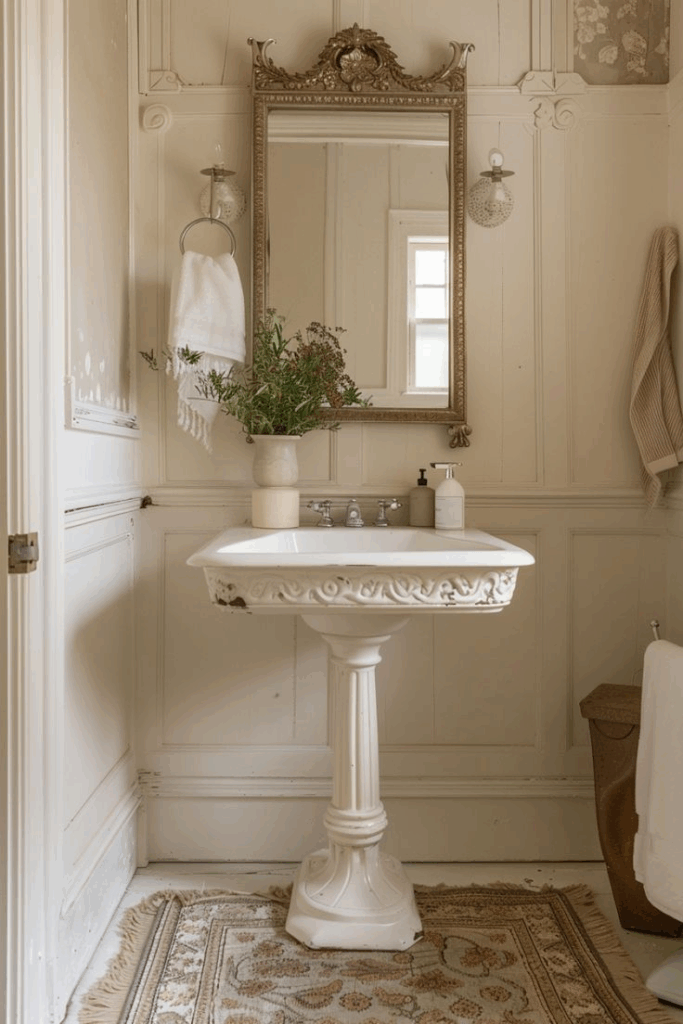
Classic pedestal sinks offer a minimalist yet historically authentic alternative to bulky modern vanities. Typically constructed from porcelain or vitreous china, these sinks keep the footprint light, making them ideal for smaller vintage bathrooms. When paired with a framed antique mirror—especially one with carved wood, gold leaf, or beveled glass—the ensemble channels early 20th-century elegance effortlessly. This pairing works especially well in bathrooms that aim to highlight original architectural features such as beadboard, transom windows, or crown molding. To enhance utility, install a slim glass shelf above the sink or mount a small wall cabinet nearby. Make sure to select faucets with cross handles or porcelain levers to maintain stylistic consistency. The charm of this look lies in its simplicity—it allows other period elements like tiled walls or clawfoot tubs to shine. Avoid modern light fixtures or frameless mirrors, which can disrupt the vintage continuity. Instead, wall sconces flanking the mirror will preserve the symmetry and traditional vibe. This combination is popular not only for its aesthetic harmony but also for its practicality, offering elegance without sacrificing everyday functionality. A pedestal sink with a vintage mirror remains a cornerstone of well-curated antique-inspired bathrooms.
Penny Tile Flooring with Border
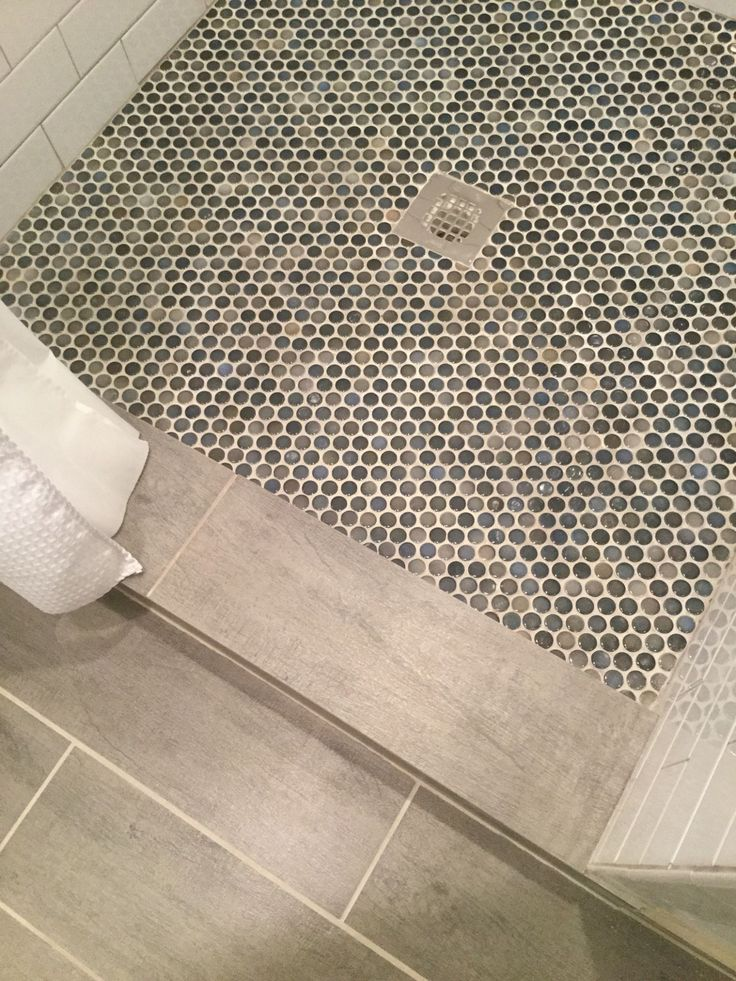
Small yet impactful, penny tile flooring bordered with a contrasting color is a defining element in vintage bathrooms. The continuous circular mosaic creates visual texture and durability underfoot. Typically, white penny tiles form the base while black or navy borders add definition and polish the overall layout. These tiles work exceptionally well in bathrooms aiming for a 1920s or 1930s look, where geometric simplicity was key. The grout choice plays a critical role—opting for a light gray or charcoal shade helps the pattern pop while also minimizing maintenance. For added authenticity, install the border along the perimeter or inlaid with a simple motif such as diamonds or Greek keys. This flooring pairs beautifully with pedestal sinks, beadboard paneling, and antique brass accents. It’s also incredibly versatile—easy to match with both pastel wall colors and darker wood cabinetry. The slip-resistant texture makes it practical for high-traffic bathrooms without compromising aesthetics. Consider radiant heat beneath the tile for added comfort in colder climates. Penny tile with a defined border doesn’t just look vintage; it brings lasting function and timeless visual appeal. It’s a staple design detail for anyone curating a true-to-era vintage bathroom.
Antique Vanity with Marble Top
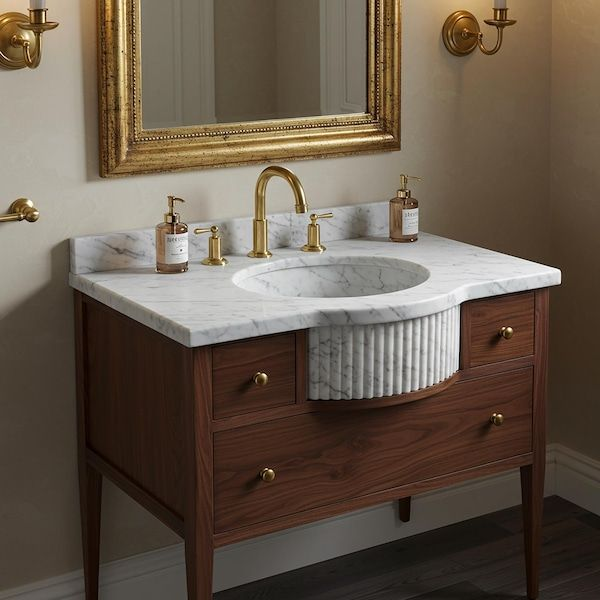
Repurposing antique dressers or cabinets into vanities topped with marble instantly sets a vintage tone. These vanities often showcase carved details, ornate hardware, and aged wood finishes that tell a story. When paired with a honed marble top—often in Carrara or Calacatta—they gain a sense of upscale permanence while still feeling authentic to period design. Undermount sinks or vessel-style basins in porcelain work best to maintain a cohesive aesthetic. The natural veining in marble adds an elegant contrast to the patina of the wood below. Wall-mounted faucets are ideal for this setup, especially in aged brass or antique bronze finishes. To complete the look, pair the vanity with a vintage mirror, candelabra-style sconces, and vintage apothecary jars for countertop styling. Seal the marble regularly to protect against stains and maintain its beauty over time. The combination of antique furniture and timeless stone appeals to those seeking uniqueness, craftsmanship, and functional elegance in one piece. This approach offers a creative solution for those who appreciate heirloom quality and want to personalize their bathroom with one-of-a-kind pieces. It continues to trend across design platforms as a top choice for bringing historical charm into modern daily routines.
Wall-Mounted Pull-Chain Toilet
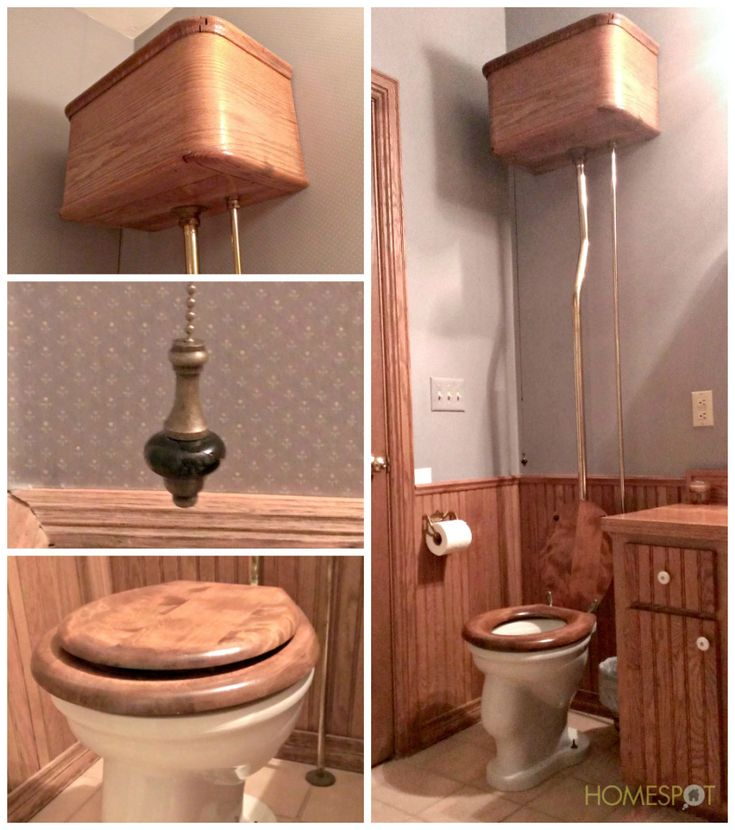
Echoing early 20th-century design, the wall-mounted pull-chain toilet introduces mechanical nostalgia into vintage bathrooms. Characterized by a high-mounted tank and long exposed pipe, it delivers architectural intrigue while remaining fully functional. These toilets often come in classic white ceramic with polished metal chains and levers, maintaining authenticity through materials and form. When installed with beadboard or paneled walls, the look becomes distinctly heritage in nature. This type of toilet pairs seamlessly with black-and-white tile flooring, clawfoot tubs, and pedestal sinks for a cohesive period atmosphere. For optimal performance, modern models integrate updated flushing systems while preserving the classic silhouette. It’s important to verify ceiling height compatibility, as the elevated tank design requires adequate vertical space. Wall bracing is also essential for secure installation. Many enthusiasts choose polished chrome or brass for the exposed plumbing, subtly coordinating it with light fixtures and other hardware. As bathrooms become more stylized, the pull-chain toilet serves both as a practical fixture and a conversation piece. It suits homeowners who want to lean fully into traditional charm without losing the reliability of modern engineering. With its vintage appeal and strong visual presence, this design element continues to earn favor among restoration purists and retro design fans alike.
Art Deco Lighting with Milk Glass Shades
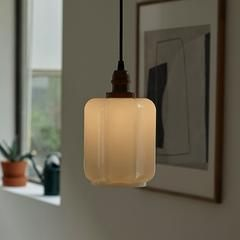
Distinctive and glamorous, Art Deco lighting featuring milk glass shades offers a period-accurate lighting option that adds character and soft ambiance to vintage bathrooms. Often composed of brass, chrome, or nickel bases with stepped or geometric silhouettes, these fixtures bring symmetry and polish to the room. The opal-white milk glass diffuses light gently, making it ideal for daily grooming without harsh glare. Wall sconces flanking the mirror or overhead fixtures centered on the ceiling both work well in this style. Look for fixtures that echo the curved lines and streamlined details of 1920s and 1930s design. Pairing this lighting with checkerboard flooring, marble vanities, and mirrored cabinetry can reinforce the overall theme. Ensure bulbs are warm-toned (2700K) to match the soft glow of vintage incandescent lighting. The enduring popularity of milk glass lies in its ability to blend seamlessly with both bold and subtle vintage color palettes, from pastels to rich jewel tones. Maintenance is simple—just wipe down shades occasionally to preserve their clarity. This lighting style isn’t just decorative; it becomes a cornerstone in recreating authentic period-inspired bathrooms, capturing the charm and glamor of a bygone design era.
Freestanding Tub with Painted Exterior
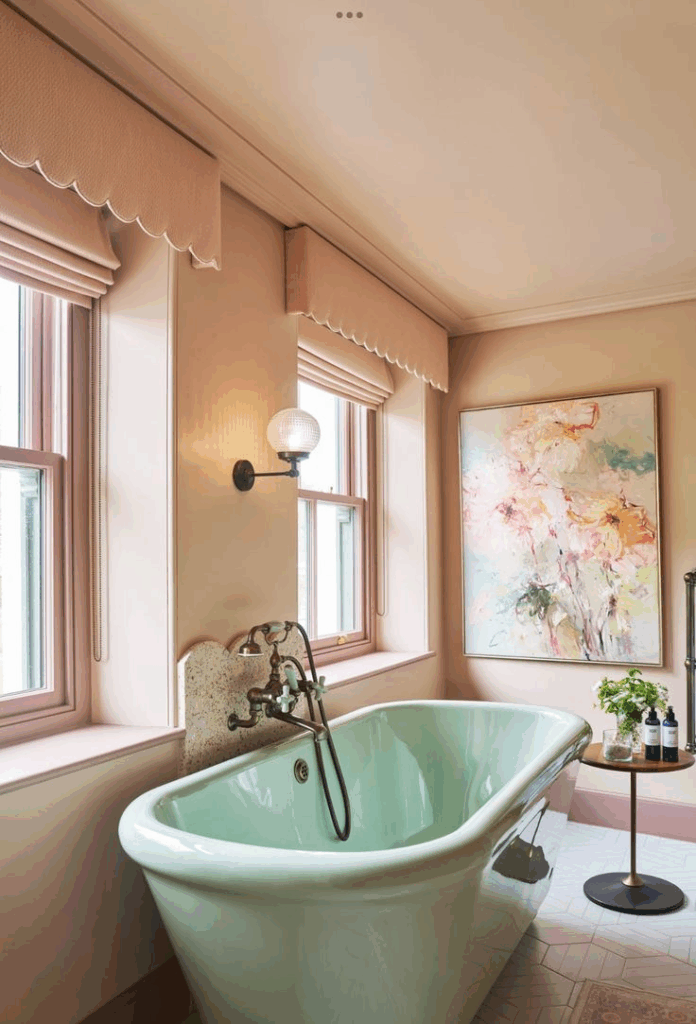
Visual interest can be heightened by painting the exterior of a freestanding tub in a color that complements the overall palette of the bathroom. This technique is particularly effective with cast iron clawfoot or skirted tubs, which offer enough surface area to showcase soft blues, sage greens, or even dramatic blacks. Unlike the interior, which remains white for hygiene and maintenance, the exterior becomes a canvas for personalization. Chalky matte or satin finishes work best to retain an aged appearance while still resisting moisture. Coordinate this accent with accessories like bath mats, window treatments, or vintage-style artwork for cohesion. To balance the look, opt for unpolished brass or rubbed bronze fixtures and surrounding neutral tones in tile and wall color. This setup suits bathrooms aiming to combine function with a distinctively vintage personality. Painted tubs have surged in popularity due to their dual role as both utility pieces and artistic centerpieces. When styled correctly, they transform the bathing space into an elegant retreat with unmistakable vintage flair. It’s a straightforward yet powerful design decision that resonates across social platforms for its timeless-meets-trendy appeal.
Beadboard Wainscoting with Pastel Walls
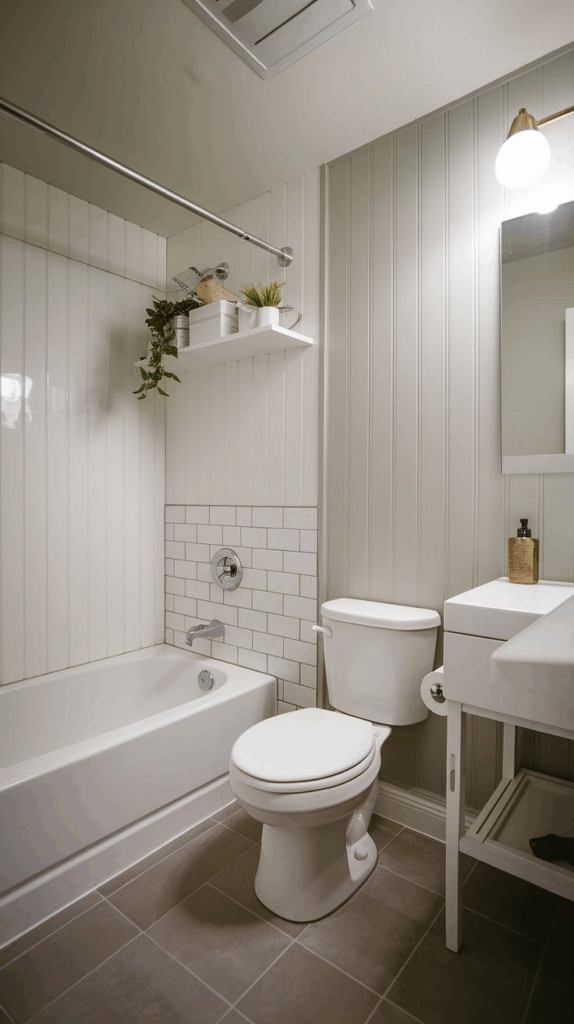
Paneling in the form of beadboard brings warmth and classic architectural texture to bathrooms, especially when paired with pastel walls. This combination harkens back to early-century American interiors, where color was used sparingly but effectively. Pale hues like blush, mint, buttercream, or powder blue create a soft backdrop that enhances the vertical rhythm of beadboard. Typically installed up to chair rail height, the paneling can be painted crisp white or matched to trim for a uniform finish. This technique not only improves wall durability but also defines the lower half of the room, making the space feel grounded. Consider pairing this combo with a pedestal sink, round frameless mirror, and antique lighting for continuity. For an extra decorative touch, add a small shelf or rail above the wainscoting for framed vintage prints or small plants. The appeal lies in the balance of simplicity and charm—it’s easy to install yet delivers strong visual and historical impact. This pairing continues to appear in vintage bathroom designs that blend farmhouse sensibility with subtle elegance, ideal for those aiming to keep things light, fresh, and historically resonant.
Vintage Medicine Cabinet with Glass Shelves
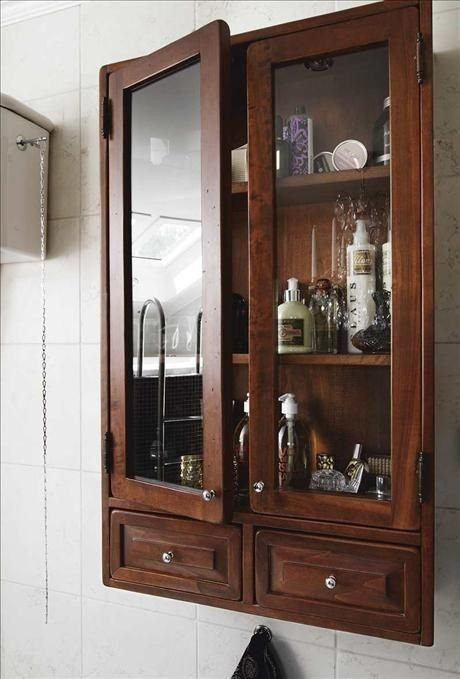
Restoring or sourcing a vintage-style medicine cabinet instantly lends authenticity and storage to a bathroom. Typically constructed with metal or wood frames and mirrored fronts, these cabinets feature interior glass shelves that reflect light and keep essentials organized. Surface-mounted styles add extra dimension to the wall, while recessed installations offer a cleaner look with the same nostalgic charm. Look for details like etched glass, latch handles, or beveled mirror edges for maximum period accuracy. When paired with subway-tiled walls or penny tile floors, the overall look becomes distinctly early-20th-century. These cabinets are functional, too—glass shelves resist moisture better than wood and are easy to clean. For styling, fill them with vintage apothecary jars, folded hand towels, or enamel accessories to maintain visual continuity. Proper lighting above or beside the cabinet ensures both form and function are upheld. Whether salvaged from a flea market or purchased as a reproduction, this piece works beautifully in bathrooms where storage and style need equal weight. It’s a reliable choice for those curating a space with character, longevity, and authentic historical influence.
Checkerboard Tile Floor in Black and White

Monochrome checkerboard floors have been a vintage staple for decades, offering strong visual impact through contrast and symmetry. Typically laid diagonally, black and white ceramic or porcelain tiles instantly evoke retro glamour while providing excellent durability. This flooring style pairs beautifully with both white subway tile walls and pastel paint choices, making it versatile across different eras—from 1920s art deco to 1950s Americana. Seal the grout lines to resist discoloration and ensure longevity. High-gloss or satin finishes can be selected depending on whether you want a reflective sheen or a softer vintage matte look. Use the flooring as an anchor to build your color palette, allowing fixtures like clawfoot tubs, pedestal sinks, or even colored toilets to shine. Checkerboard patterns aren’t limited to just large spaces—they also create a sense of depth and rhythm in compact bathrooms. Vintage fixtures with chrome or brass details work especially well against this dramatic floor. Still trending in today’s design scene, black-and-white checkerboard tile remains a reliable and recognizable element that instantly signals vintage charm.
Retro Color Palette with Pink and Mint Green

Color choices rooted in the 1950s—specifically pastel pinks and mint greens—offer a cheerful throwback look that reads distinctly retro. These colors frequently adorned tile walls, toilets, sinks, and bathtubs during the postwar era, and they’re seeing a resurgence among vintage bathroom enthusiasts. For walls, soft mint provides a refreshing base, while blush pink fixtures or tiles add warmth. High-gloss ceramic tile is especially fitting for this color scheme and offers easy maintenance. White or chrome accents prevent the palette from feeling too saccharine, bringing visual balance. To strengthen the nostalgic aesthetic, incorporate metal-rimmed mirrors, glass toothbrush holders, and fluted lighting fixtures. Vinyl flooring in coordinating colors or terrazzo tiles can further support the retro vibe. Even small additions like a pink shower curtain or mint green storage basket help reinforce the palette without full-scale remodeling. These cheerful tones are ideal for those looking to make their bathroom a vibrant, personality-filled space that celebrates the past without compromising on modern usability. This palette proves that vintage doesn’t always mean muted—it can be lively, fresh, and undeniably fun.
Reclaimed Wood Accents and Open Shelving
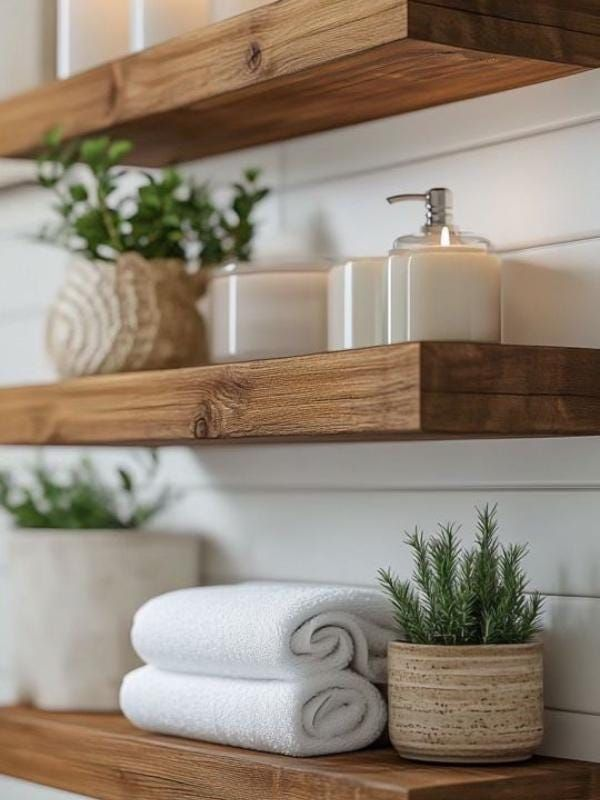
Character-driven bathrooms benefit immensely from the inclusion of reclaimed wood accents, especially when used in open shelving. Whether it’s a repurposed barn board for towel storage or antique crates mounted as floating shelves, the natural grain and imperfections add warmth and authenticity. This organic texture complements cooler surfaces like tile and porcelain, bridging the gap between rustic charm and vintage styling. Use wood with a medium to dark finish for visual depth, especially against lighter wall colors. Ensure proper sealing or choose wood treated to resist humidity in bathroom settings. Open shelving allows everyday items like rolled towels, glass jars, or vintage perfume bottles to become decorative features. To maintain the antique feel, opt for iron brackets, worn brass hooks, or vintage-style labels. This blend of practicality and charm continues to dominate vintage bathroom ideas on Pinterest and Instagram. The key is balance—enough open storage to be useful, but curated so it doesn’t feel cluttered. Reclaimed wood brings an irreplaceable lived-in quality to the space and instantly sets a vintage tone.
Vintage-Inspired Faucets with Cross Handles
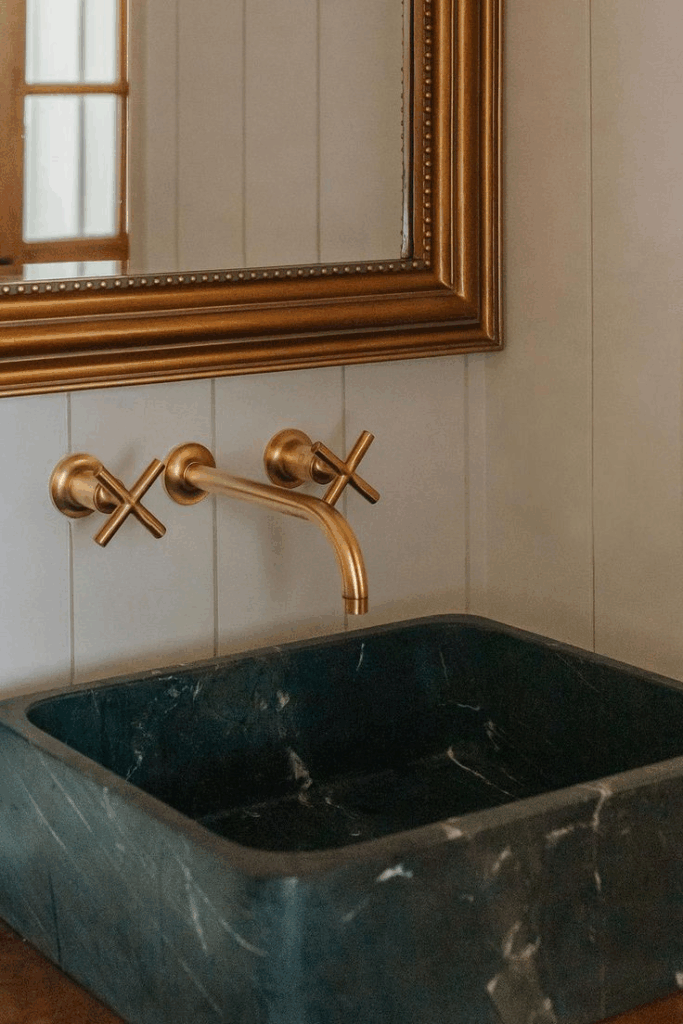
Hardware is often the defining detail in a vintage bathroom, and faucets with cross handles deliver both period accuracy and tactile charm. Inspired by early 1900s designs, these faucets are typically finished in brushed brass, chrome, or oil-rubbed bronze and feature separate hot and cold knobs. The cross design isn’t just decorative—it offers better grip and control. Install them on pedestal sinks, console vanities, or even freestanding tubs to stay stylistically consistent. Pairing them with ceramic labels like “H” and “C” can push the vintage feel further. Wall-mounted versions are ideal for marble vanities or apron-front sinks. Modern manufacturers now offer these designs with ceramic disc valves, blending old-world aesthetics with modern reliability. Keep the rest of the plumbing fixtures in the same finish to maintain harmony across the room. For added flair, consider exposed piping underneath the sink, especially if finished in a matching tone. These faucets are more than nostalgic—they’re practical, easy to maintain, and work seamlessly within a wide range of vintage aesthetics.
Decorative Wall Sconces with Fabric Shades
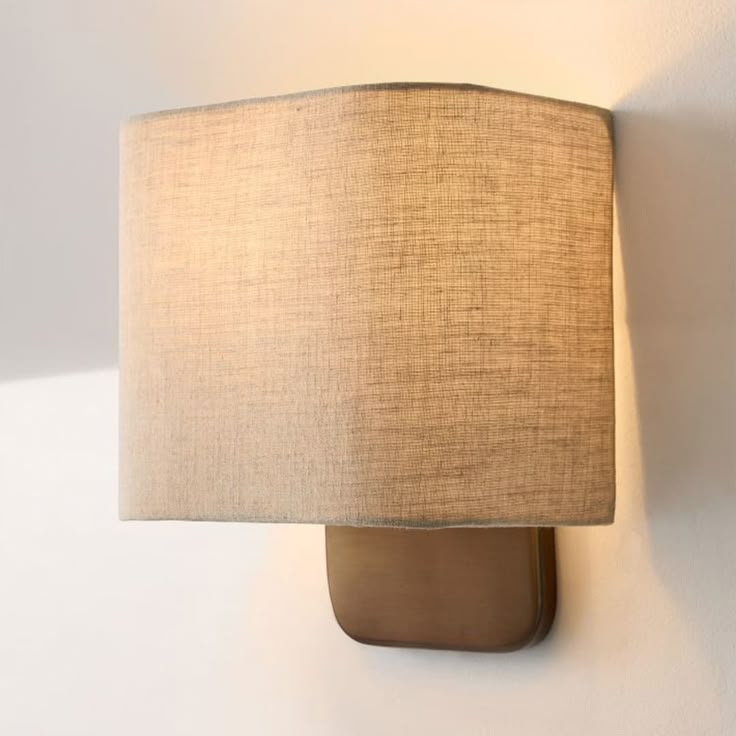
Lighting often dictates the mood of a room, and decorative wall sconces with fabric shades lend a warm, ambient glow that enhances vintage charm. Installed on either side of a vanity mirror or framing a freestanding tub, these fixtures soften the space both visually and functionally. Fabric shades—especially in pleated linen, floral chintz, or embroidered patterns—create a cozy, lived-in effect that balances the harder surfaces found in bathrooms. Opt for fixtures with aged brass, antique bronze, or matte black bases to complement the period vibe. These sconces pair exceptionally well with clawfoot tubs, floral wallpapers, and painted beadboard. For small bathrooms, sconces provide layered lighting without overwhelming the layout. Select dimmable bulbs to allow for lighting versatility, especially useful during relaxing evening routines. To enhance continuity, repeat the fabric motif in window treatments or shower curtains. This style choice resonates deeply with those aiming for a bathroom that feels collected and gently aged rather than over-designed. It’s an accessible, low-commitment way to bring unmistakable vintage appeal into any bathroom design.
